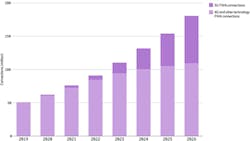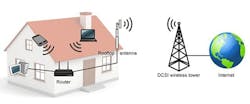FWA Is All About Quality Infrastructure
Fixed wireless access (FWA) connections are forecast to grow more than threefold and reach over 180 million by the end of 2026, accounting for around 25% of total mobile network data traffic globally. (See Figure 1.)
There’s good reason why. A recent white paper by the GSMA compares download speeds available through different broadband access technologies. (See Figure 2.) It illustrates a speed gain from 4G to 5G FWA of up to 10× or more (depending on the deployment scenario). While actual speeds are likely to be lower in practice, any deficit compared to fiber and cable will be far less than with 4G. This will likely be indistinguishable to an average household, as most bandwidth-hungry use cases, such as video streaming and even multiplayer gaming, do not require more than 200-300 Mbps.
The report also says CPE shipments are likely to expand significantly to an estimated 250–350 million over the next 5 years, based on a range of industry estimates. The vast majority will be 5G, driven by falling costs. This will make FWA more competitive compared to fixed-line alternatives, either in direct competition or to complement the other access technologies of an operator.
Indeed, Fixed Wireless Access (FWA) is a cost-effective way to deliver broadband services in remote and hard-to-serve areas. However, the success of FWA depends on the network infrastructure, the equipment you deploy, and the maintenance you do after the customer has signed on.
6 Considerations
To lay a high-quality network infrastructure for your FWA project, be sure to address 6 often overlooked considerations related to developing, implementing, and maintaining an FWA network.
1. Develop Your Plan
FWA uses a dedicated point-to-multipoint radio link to provide broadband services in remote locations lacking wired access networks. It encompasses a wide range of rural wireless technologies, including DSL, HSPA/WCDMA (3G), WiMAX, and LTE. In addition, many FWA networks utilize use multi-layer FR4 printed circuit boards. (See Figure 3.)
Be sure your chosen technology is compatible with the current/legacy network infrastructure and equipment in the deployment area. Each choice must work well with the terrain in which it will operate. Together, the legacy and new equipment must provide sufficient capacity and mitigate the risk of signal obstructions. For example, think about line-of-sight comparisons when deploying across a corn field versus mountains.
Another consideration are the site towers that support FWA antennas. If your plan is to build towers, you must work with local government representatives and landowners to secure permission to place towers on private property. Antenna co-location on existing sites requires partnering between with organizations that control the infrastructure. These could also include other mobile providers.
2. Design For FWA Success
Select radio equipment compatible with the antennas to be used, and ensure that it has sufficient output power to reach all intended customers. It’s also important to have sufficient processing capabilities to handle a high number of concurrent calls while maintaining good voice quality.
Remember to consider the terrain obstruction effects on wireless signals. A site survey should be conducted to evaluate the suitability of equipment and antennas.
It’s also important to choose outdoor multi-band antennas with gain-control capacity as well as antenna polarization diversity. The right decision ensures adequate coverage and signal quality at all customer locations. (See Figure 4.)
Ease of CPE installation should not be underrated in the current COVID-19 environment. For some customers, social distancing guidelines have resulted in delays to customer upgrades in which a provider switch is involved and an engineer visit is required to activate a connection.
The other important change with CPE is the need for a streamlined installation process. This removes the requirement for aerial installation on roofs or other outdoor fascia, with a single router installed indoors on a plug-and-play basis — in line with most other broadband products.
3. Prepare For Proactive Maintenance
Leverage radio equipment that enables you to monitor the network remotely. Clearly, this facilitates troubleshooting efforts which can help reduce operational expenses.
Be sure the radio equipment has an air temperature sensor that automatically turns off the device if/when temperatures soar above safety thresholds for extended periods.
Ensure you have an adequate number of radio units to minimize the impact of interference and ensure that sufficient signal power is available at all customer locations. Consider directional antennas, which provide better coverage than omnidirectional antennas.
Use low-loss connectors and cable assemblies to help minimize signal loss throughout the network. This will help voice quality and bandwidth performance while avoiding the oversubscription of radio equipment.
Design the FWA layout and radio unit placement so signal strength is not concentrated in one area, such as the center of a cell.
Also make sure that network equipment has suitable grounding and lightning protection against surges generated by mobile radio units. Lightning arrestors should be placed at regular intervals along the cable to ensure proper operation.
Use variable gain amplifiers to compensate for signal level variations at customer locations. With this approach, you can control the gain of each amplifier to prevent overloading and minimize the impact of multi-path fading.
Finally, use an outdoor enclosure to house your radio equipment and be sure it has an adequate power supply. This protects equipment from the weather and provides stable power to the radio unit.
4. Monitor Reliability
Set up a radio management system to remotely monitor the radio network, including the number and type of calls served as well as performance metrics. This tool helps optimize call quality while preventing signal overload at all customer locations.
Install a wireless intrusion detection system (WIDS) or intrusion prevention system (IPS) to monitor the radio network for malicious activity such as jamming and other illegal transmissions. This prevents signal contamination which can degrade call quality and interfere with your ability to meet service level agreements (SLAs).
5. Implement Customer Premises Equipment (CPE)
Provide your customers with high-quality CPE to help them maximize the performance of the FWA. For example, install a network termination device with an integrated wireless LAN interface card (PCI or USB) that supports 802.11n and incorporates High-Speed DSL technology. This allows customers to get faster access speeds and ensures that they can connect to the Internet using standard Ethernet cables.
Give users a High-Speed DSL CPE. This helps them achieve faster speeds than are possible through conventional FWA equipment without sacrificing voice quality or bandwidth. Implementing a stand-alone unit with 2 integrated DSL ports can support 2 simultaneous calls with High-Speed DSL technology.
Also install broadband adapters to accommodate various connection standards, including POTS, ADSL, and FWA, service. These devices help customers get faster access speeds and ensure that they can connect to the Internet using standard Ethernet cables.
6. Enhance The Customer Experience
To enhance your customers’ experience, offer them web-based services to get the most from their FWA service. They should be able to control all of their voice and data services via a single location. This simplifies the management process for you and helps improve customer satisfaction.
Secondly, deliver voice services with advanced features designed to help them stay connected. For example, implement HD Voice technology and support services to ensure outstanding call quality in high noise or windy environments. Also, ensure that they can easily transfer their numbers when moving homes or changing operators. This helps you retain customers and reduce churn.
Ensure that there is a functional 24/7 customer support center staffed by specially trained personnel who can help them solve problems with their FWA service, including setup assistance and troubleshooting any connectivity issues. This helps ensure that they get the best possible service and prevent potentially expensive delays in resolving any issues they have with connectivity.
Lastly, offer customers a 1-year part and labor warranty on all FWA equipment, including antennas, CPEs, and signal boosters, to help them be satisfied for the long-term.
As FWA rollout continues, it is important to embrace these 6 simple principles to get ahead of FWA demand.
Planning Is Everything
In conclusion, by following the tips and tricks we’ve discussed here you are able to create a network infrastructure that is scalable, robust, and high-quality. The quality of the infrastructure you lay for your FWA network is essential to its success. Don’t underestimate how much work it takes to design, implement, and maintain, a high-quality wireless access network.
Resources and Notes
https://www.mktpcb.com/pcb-fab/multilayer-pcb/?nowprocket=1
Figure 1: http://www.ericsson.com, April, 2021
Figure 2: https://assets.foleon.com/eu-west-2/uploads-7e3kk3/4816/5g_playbook.efdc80c74f0b.pdf
Figure 3: https://www.everythingrf.com/community/what-is-fixed-wireless-access
Figure 4: https://www.gsma.com/futurenetworks/5g/fixed-wireless-access-economic-potential-and-best-practices/
Why The Global Digital Divide Persists
https://en.wikipedia.org/wiki/Customer_service
For more information, please email [email protected]. You can also visit https://www.mktpcb.com/, and for the Company profile, please visit: https://www.mktpcb.com/about/?nowprocket=1.









